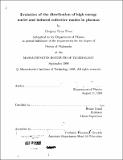| dc.contributor.advisor | Bruno Coppi. | en_US |
| dc.contributor.author | Penn, Gregory Evan, 1969- | en_US |
| dc.date.accessioned | 2009-08-26T17:00:19Z | |
| dc.date.available | 2009-08-26T17:00:19Z | |
| dc.date.copyright | 1998 | en_US |
| dc.date.issued | 1998 | en_US |
| dc.identifier.uri | http://hdl.handle.net/1721.1/46596 | |
| dc.description | Thesis (Ph.D.)--Massachusetts Institute of Technology, Dept. of Physics, 1998. | en_US |
| dc.description | Includes bibliographical references (p. 177-181). | en_US |
| dc.description.abstract | Recent experiments in plasmas undergoing fusion have shown evidence of novel processes which are correlated with the onset of fusion reactions. In view of such evidence and observed effects of the injection of high energy neutral beams in laboratory plasmas, as well as the existence of subpopulations of high energy particles in astrophysical plasmas, there is a rich variety in the possible interactions of energetic nuclei within a plasma. This thesis examines the effects of the He nuclei produced by fusion in a magnetically confined plasma. Both single-particle effects and interactions with collective modes in the plasma will be considered. Part of this research will focus on the distribution of high energy nuclei undergoing motion in unperturbed orbits. This work utilizes appropriate symmetry properties and conservation laws, including the conservation of angular momentum in a toroidally symmetric configuration. Considering the various time scales involved in the evolution of the distribution function, a reasonable form for the distribution function of fusion products is derived. With this distribution function, basic properties such as the first-orbit losses out of the plasma chamber and geometric effects on the distribution function can be deduced. A major role is played by magnetically trapped particles, which can undergo wide excursions away from magnetic field surfaces due to their high energy. The resulting distribution function displays a strong contrast between the central region of the plasma, where the fusion reaction rate for the production of a-particles is greatest, and the outermost regions of the plasma. In particular, at the outer edge particles are concentrated furthest away from the symmetry axis of the toroidal configuration, where the magnetic field is at its lowest. The velocity-space distribution function is dominated by trapped particles which undergo large radial excursions; these particles are not deeply trapped and have pitch angles close to those of passing particles. Another topic examined is the resonant interactions of fusion products with an internal mode of the plasma referred to as the "contained mode", whose local properties are analogous to those of a magnetosonic-whistler wave. The resonance occurs for modes whose frequency lies at multiples of the cyclotron frequency of the energetic particles. The contained mode has been shown to be localized in a thin radial shell towards the edge of the plasma column. Key features examined are the mode frequency, localization and radial extent of the mode, and how these properties are affected by the direction of mode propagation. As these modes can have frequencies larger than the fusion product cyclotron frequency, they can undergo resonant interactions with the small population of particles formed by fusion processes. Such interactions can lead to an instability of the collective mode which draws energy from the fusion products. The induced growth rates are calculated for parameters typical of recent experiments in burning plasmas resulting in the formation of a-particles. These experiments have observed enhanced radiation emission at harmonics of the fusion product cyclotron frequencies and it is argued that this anomalous ion cyclotron emission (ICE) is associated with the excitation of the contained modes by a-particles. According to this model, this emission can yield information about the a-particle distribution. In addition, these modes will modify the distribution of a-particles, offering an alternative to collisional processes for the exchange of energy with the background plasma of which slowing down of a-particles on electrons predominates. Such a mechanism would impart energy from fusion to the plasma ions without having to first heat the electron population. The effects of the eventual loss of energy of a-particles to this collective mode are illustrated and compared to collisions. | en_US |
| dc.description.statementofresponsibility | by Gregory Evan Penn. | en_US |
| dc.format.extent | 181 p. | en_US |
| dc.language.iso | eng | en_US |
| dc.publisher | Massachusetts Institute of Technology | en_US |
| dc.rights | M.I.T. theses are protected by
copyright. They may be viewed from this source for any purpose, but
reproduction or distribution in any format is prohibited without written
permission. See provided URL for inquiries about permission. | en_US |
| dc.rights.uri | http://dspace.mit.edu/handle/1721.1/7582 | en_US |
| dc.subject | Physics | en_US |
| dc.title | Evolution of the distribution of high energy nuclei and induced collective modes in plasmas | en_US |
| dc.type | Thesis | en_US |
| dc.description.degree | Ph.D. | en_US |
| dc.contributor.department | Massachusetts Institute of Technology. Department of Physics | en_US |
| dc.identifier.oclc | 42282783 | en_US |
